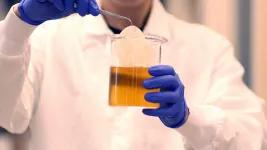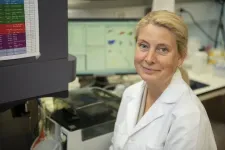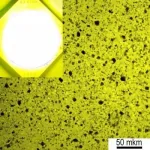(Press-News.org) Cell phone data that is routinely collected by telecommunications providers can reveal changes of behavior in people who are diagnosed with a flu-like illness, while also protecting their anonymity, a new study finds. The Proceedings of the National Academy of Sciences (PNAS) published the research, led by computer scientists at Emory University and based on data drawn from a 2009 outbreak of H1N1 flu in Iceland.
"To our knowledge, our project is the first major, rigorous study to individually link passively-collected cell phone metadata with actual public health data," says Ymir Vigfusson, assistant professor in Emory University's Department of Computer Science and a first author of the study. "We've shown that it's possible to do so without comprising privacy and that our method could potentially provide a useful tool to help monitor and control infectious disease outbreaks."
The researchers collaborated with a major cell phone service provider in Iceland, along with public health officials of the island nation. They analyzed data for more than 90,000 encrypted cell phone numbers, which represents about a quarter of Iceland's population. They were permitted to link the encrypted cell phone metadata to 1,400 anonymous individuals who received a clinical diagnosis of a flu-like illness during the H1N1 outbreak.
"The individual linkage is key," Vigfusson says. "Many public-health applications for smartphone data have emerged during the COVID-19 pandemic but tend to be based around correlations. In contrast, we can definitively measure the differences in routine behavior between the diagnosed group and the rest of the population."
The results showed, on average, those who received a flu-like diagnosis changed their cell phone usage behavior a day before their diagnosis and the two-to-four days afterward: They made fewer calls, from fewer unique locations. On average, they also spent longer time than usual on the calls that they made on the day following their diagnosis.
The study, which began long before the COVID-19 pandemic, took 10 years to complete. "We were going into new territory and we wanted to make sure we were doing good science, not just fast science," Vigfusson says. "We worked hard and carefully to develop protocols to protect privacy and conducted rigorous analyses of the data."
Vignusson is an expert on data security and developing software and programming algorithms that work at scale.
He shares first authorship of the study with two of his former students: Thorgeir Karlsson, a graduate student at Reykjavik University who spent a year at Emory working on the project, and Derek Onken, a Ph.D. student in the Computer Science department. Senior author Leon Danon -- from the University of Bristol, and the Alan Turing Institute of the British Library -- conceived of the study.
While only about 40 percent of humanity has access to the Internet, cell phone ownership is ubiquitous, even in lower and middle-income countries, Vigfusson notes. And cell phone service providers routinely collect billing data that provide insights into the routine behaviors of a population, he adds.
"The COVID pandemic has raised awareness of the importance of monitoring and measuring the progression of an infectious disease outbreak, and how it is essentially a race against time," Vigfusson says. "More people also realize that there will likely be more pandemics during our lifetimes. It is vital to have the right tools to give us the best possible information quickly about the state of an epidemic outbreak."
Privacy concerns are a major reason why cell phone data has not been linked to public health data in the past. For the PNAS paper, the researchers developed a painstaking protocol to minimize these concerns.
The cell phone numbers were encrypted, and their owners were not identified by name, but by a unique numerical identifier not revealed to the researchers. These unique identifiers were used to link the cell phone data to de-identified health records.
"We were able to maintain anonymity for individuals throughout the process," Vigfusson says. "The cell phone provider did not learn about any individual's health diagnosis and the health department did not learn about any individual's phone behaviors."
The study encompassed 1.5 billion call record data points including calls made, the dates of the calls, the cell tower location where the calls originated and the duration of the calls. The researchers linked this data to clinical diagnoses of a flu-like illness made by a health providers in a central database. Laboratory confirmation of influenza was not required.
The analyses of the data focused on 29 days surrounding each clinical diagnosis, and looked at changes in mobility, the number of calls made and the duration of the calls. They measured these same factors during the same time period for location-matched controls.
"Even though individual cell phones generated only a few data points per day, we were able to see a pattern where the population was behaving differently near the time they were diagnosed with a flu-like illness," Vigfusson says.
While the findings are significant, they represent only a first step for the possible broader use of the method, Vigfusson adds. The current work was limited to the unique environment of Iceland: An island with only one port of entry and a fairly homogenous, affluent and small population. It was also limited to a single infectious disease, H1N1, and those who received a clinical diagnosis for a flu-like illness.
"Our work contributes to the discussion of what kinds of anonymous data lineages might be useful for public health monitoring purposes," Vigfusson says. "We hope that others will build on our efforts and study whether our method can be adapted for use in other places and for other infectious diseases."
INFORMATION:
Co-authors include the late Gudrun Sigmundsdottoir, directorate of health for Iceland's Center for Health Security and Communicable Disease Control; Congzhang Song (Cornell University); Atil Einarsson (Reykjavik university); Nishant Kishore (Harvard); Rebecca Mitchell (formerly with Emory's Nell Hodgson Woodruff School of Nursing); and Ellen Brooks-Pollock (University of Bristol).
The work was funded by the Icelandic Center for Research, Emory University, the National Science Foundation, the Leverhulme Trust, the Alan Turing Institute, the Medical Research Council and a hardware donation from NVIDIA Corporation.
WASHINGTON -- A multi-institutional group of researchers has developed new metamaterial tiles that will help improve the sensitivity of telescopes being built at the preeminent Simons Observatory in Chile. The tiles have been incorporated into receivers that will be deployed at the observatory by 2022.
The Simons Observatory is the center of an ambitious effort to measure the cosmic microwave background -- electromagnetic radiation left over from an early stage of the universe -- using some of the world's largest and most sophisticated ground-based telescopes. ...
Providing economic relief to struggling families can lead to another positive effect -- fewer cases of child neglect, according to new research by the University of Washington.
A 10% increase in a common benefit for low- to moderate-income working families, the Earned Income Tax Credit, led to a 9% decrease in the annual number of reports of child neglect made to child welfare agencies over a 14-year study period. That's a significant impact, researchers say, and can inform future social policies.
The study is relevant to current policy actions, as President Joe Biden has recently proposed an expansion ...
RESEARCH TRIANGLE PARK, N.C. -- Kombucha tea, a trendy fermented beverage, inspired researchers to develop a new way to generate tough, functional materials using a mixture of bacteria and yeast similar to the kombucha mother used to ferment tea.
With Army funding, using this mixture, also called a SCOBY, or symbiotic culture of bacteria and yeast, engineers at MIT and Imperial College London produced cellulose embedded with enzymes that can perform a variety of functions, such as sensing environmental pollutants and self-healing materials.
The team also showed that they could incorporate yeast directly into the cellulose, creating living materials that could be used to purify water for Soldiers in the field or make smart packaging materials that can detect damage.
"This ...
COLUMBIA, Mo. - In 2016, the World Health Organization called the Zika virus epidemic a "public health emergency of international concern" due to the virus causing birth defects for pregnant women in addition to neurological problems. Since then, researchers have wrestled with different strategies for controlling the spread of Zika virus, which gets transmitted to humans from female mosquito bites.
One approach, which was approved by the Environmental Protection Agency in May, will release more than 750 million genetically modified mosquitos into the Florida Keys in 2021 and 2022. These "suicide mosquitos" are genetically-altered to produce offspring that die before emerging into adults and therefore cannot ...
An international research collaboration, involving scientists from the UK, US and Spain, has shed new light on the usefulness of digital contact tracing (DCT) to control the spread of Covid-19.
The study, published today in Nature Communications, assessed the effectiveness of the Spanish DCT app, Radar COVID, following a 4-week experiment conducted in the Canary Islands, Spain between June-July 2020.
For the experiment, funded by the Secretary of State of Digitalisation and Artificial Intelligence (SEDIA), the researchers simulated a series of Covid infections in the capital of La Gomera, San Sebastián de la Gomera, to understand whether the Radar COVID app technology could ...
Individual variations in how the immune system responds to SARS-CoV-2 appear to impact the severity of disease. Researchers at Karolinska Institutet in Sweden have now been able to show that patients with severe COVID-19 have significantly elevated levels of a certain type of immune cells in their blood, called myeloid-derived suppressor cells. The study published in the Journal of Clinical Investigation may bring an increased understanding of how early immune responses impact disease severity.
Most individuals with COVID-19 develop mild to moderate symptoms and recover without needing hospital treatment. In severe cases, however, COVID-19 can lead to respiratory failure or even death. It is not yet known ...
Materials scientists of Far Eastern Federal University (FEFU), in collaboration with an international research team, have advanced the design of composite ceramic materials (Ce3+:YAG-Al2O3), i.e. solid-state light converters (phosphors) that can be applied in-ground and aerospace technologies. The LED systems based on the developed materials to save 20-30 percent more energy compared to commercial analogues. A related article was published in Materials Characterization.
Over 15% of the total global electricity production or about $ 450 billion annually spent on lighting. According to the photonics development roadmap run in Russia, the development of LED technology with an efficiency of more than 150 ...
Canada could be sitting on a significant untapped resource, as the number of PhD holders in this country rises, but persistent barriers make it hard for them to put their skills to work. According to a new expert panel report from the Council of Canadian Academies (CCA), PhD graduates play a critical role in the Canadian economy, but many are missing out on important opportunities to contribute their expertise and bolster growth and innovation.
"The growing number of PhD graduates in Canada could represent a significant opportunity to drive innovation and increase our competitiveness in a global economy," said M. Elizabeth Cannon, O.C., PhD, FRSC, FCAE, Chair of the Expert Panel. "The difficulties graduates face raise important questions about the nature of PhD ...
"74 percent of the respondents consider the national vaccination strategy to be appropriate," says BfR-President Professor Dr. Dr. Andreas Hensel. "This indicates that the strategy is accepted."
While some regulations, such as the cancellation of events or the quarantine measures, have always been met with approval in recent months, other measures are now less accepted. Whereas shortly before Christmas, 84 percent of the respondents considered the contact restrictions to be appropriate, 74 percent say so in the current survey. Over the same period, approval of the closure of shops fell by ten percentage points to 56 percent.
In the previous ...
BROOKLYN, New York, Monday, January 26, 2021 - Atomically thin, 2D hexagonal boron nitride (h-BN) is a promising material whose protean ability to undergo phase transformations to strong, super lightweight, chemically stable, oxidation-resistant films makes them ideal for protective coatings, nanotechnology thermal applications, deep-UV light emitters, and much more.
The possibilities embodied in different polytypes of h-BN include the ultra-hard diamond phase, a cubic structure (c-BN) with strength and hardness second only to actual carbon diamonds. Key to fabricating such materials is the ability to induce and control the transformation between their various crystalline phases, in a way that is efficient and cost effective enough to allow for economies of scale.
While ...




